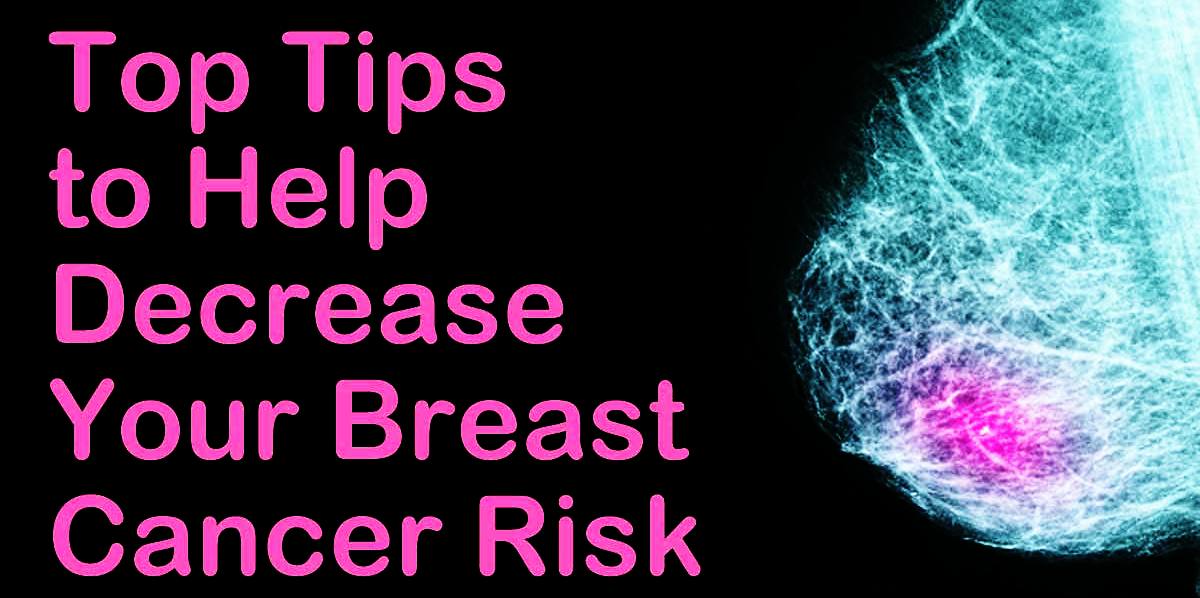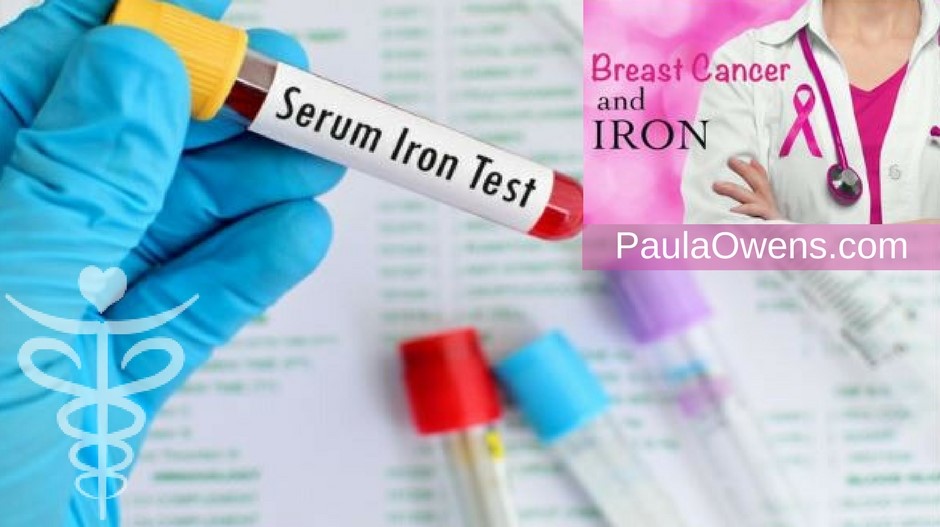Educating and Empowering You to Heal, Thrive, and Live a Happy, Healthy Lifestyle
Tips to Reduce Your Risk of Breast Cancer

Breast cancer and other estrogen dominant cancers such as endometrial, cervical, uterine, ovarian and prostate cancer are often fueled by excess estrogen. Exposure to higher levels of both exogenous (environmental) and endogenous (self-made) estrogen is associated with an increased risk of breast cancer and other estrogen dominant cancers, liver damage, fibroids (fibrocystic breasts), endometriosis, obesity, diabetes, and thyroid disorders.
Less than 10% of all estrogen-dominant cancers cases are thought to be related to genetic risk factors — 90% appear to be triggered by diet, environmental, and lifestyle factors.
Different Types of Breast Cancer
Breast cancer is often diagnosed by receptor type. Hormone receptor status refers to breast cancer cells that have certain proteins that are estrogen or progesterone receptors. Breast cancer cells can have one, both, or none of these receptors.
- Hormone receptor (estrogen receptor positive, progesterone receptor negative). Approximately 75% of breast cancers are HER2-negative cancer, meaning it is a node-negative, hormone receptor positive type of cancer that grows in response to the hormone, estrogen. About 65% of these are also PR positive and grow in response to the hormone, progesterone.
- HER-2 positive cancer. 20-25% of breast cancers are HER-2 positive; the cancer cells make too much of a protein known as HER2/neu. This breast cancer tends to be much more aggressive and fast-growing.
- Triple negative breast cancer is an extremely aggressive form of breast cancer. It is not positive to receptors for estrogen, progesterone, or HER-22. Approximately 10-12% are known as “triple negative” because they lack estrogen and progesterone receptors and do not over-express the HER2 protein.
This article focuses reducing risk of estrogen-sensitive cancers such as breast and prostate cancer.
Risk Factors for Estrogen-sensitive Breast Cancer
— Poor methylation and poor detoxification pathways
— Inherited genetic mutations, specifically mutations of the BRCA1 and BRCA2 repair genes play a role in about 5% to 10% of breast cancer cases. Gene mutations, specifically of the genes BRCA1, BRCA2, and p53 are associated with a 40% to 85% lifetime risk of developing breast cancer. In addition to the BRCA gene, there are other genetic variants such as COMT, MTHFR, cytochrome P450 and many others to factor into the equation regarding risk of estrogen dominant cancers.
It is important to realize that through epigenetics (lifestyle, environment, diet, addressing hidden infections, chemical, physical and emotional stressors, supporting methylation, and reducing toxic load), the BRCA gene mutation has less of a chance of being expressed.
— Stagnant, congested lymph. When lymph fluid is sluggish and congested, cancer cells can thrive and breast cancer can develop. Breast cancer and lymphedema are closely related.
— A sluggish, congested liver caused by the foods we eat, the air we breathe, the products we put on our skin, toxic chemicals in the environment we’re exposed to, and the beverages we drink. A healthy functioning liver is essential for removing excess estrogen. According to Harvard physician, John R. Lee., M.D., “anything that impairs liver function or ties up the detoxifying function will result in excess estrogen levels.”
— High estrogen aka estrogen dominance. Estrogen alone is not the issue when it comes to increasing the risk of breast cancer. The real issue is how your estrogen is being metabolized. The liver converts estrogens into estrogen metabolites (the good) 2-hydroxyestrone (2-OH), (the bad) 16-alpha-hydroxyestrone (16a-OH), and (the ugly) 4-hydroxyestrone (4-OH). The 2-OH metabolite has weaker estrogenic activity and is protective. The 4-OH and 16a-OH have a greater amount of estrogenic activity, and can be harmful and carcinogenic.
— Hidden infections including dental infections, pathogens in the mouth, old root canaled teeth, parasites, viruses, Candida overgrowth, yeast, fungal and bacterial infections, mold, Lyme disease
— Excessive alcohol consumption and smoking increase the risk of breast cancer
— Nutrient deficiencies, specifically iodine, selenium, vitamin D, zinc, vitamin A and other important nutrients
— Obesity
— Postmenopausal women with hormonal imbalances, specifically increased levels of hormones including estradiol, estrone and testosterone are at increased risk for developing breast cancer
— Hormone-disrupting chemicals, estrogen-disrupting chemicals and environmental toxins that include:
*** Food sources: pasteurized dairy, processed carbs, wheat and grains, factory-farmed animal protein, processed soy, and non-organic foods loaded with synthetic xenoestrogens, pesticides, antibiotics, glyphosate and GMOs.
***Prescription drugs. Hormone replacement therapy, oral contraceptives, antidepressants, anti-fungals, antibiotics, corticosteroids, anabolic steroids, diuretics, and liver activity drugs.
***Environmental endocrine-disrupting chemicals including plastics, BPA, PCBs, pesticides, parabens, soaps, emulsifiers, hand sanitizers (triclosan), thermal receipts, phthalates, flame retardants, artificial fragrances and many other chemicals found in personal care and household cleaning products.
***Hair products are one of the many sources of potential endocrine disruptors and carcinogens in our environment. A study published in the International Journal of Cancer reported a higher risk of breast cancer for women using permanent hair dye and chemical hair straightener. The risk is more than 6x higher for black women.
***Heavy metal toxicity. Mercury is a metalloestrogen, meaning it mimics estrogen by binding estrogen receptors
***Iron overload increases risk of breast cancer
A 2014 study published in the American Chemical Society’s journal Chemical Research in Toxicology found that triclosan and octylphenol promoted the growth of human breast cancer cells. Avoid products that contain these two toxic chemicals.
How to Reduce Your Risk of Breast Cancer
 Use Food as Medicine to Reduce Breast Cancer Risk
Use Food as Medicine to Reduce Breast Cancer Risk
Buy organic! This is a must in order to limit exposure to damaging pesticides, chemicals, herbicides, glyphosate, GMOs and synthetic hormones.
- Animal protein must be 100% grass-fed, pasture-raised, free-range and organic versus factory-farmed animal protein due to the abundance of synthetic xenohormones, pesticides, glyphosate, antibiotics and GMOs. Remember, you eat what the animal has been fed and injected with.
- Include cancer-fighting organic cruciferous veggies (also known as bassica veggies) such as broccoli, watercress, cauliflower, kale, Brussel sprouts, mustard greens, turnips, arugula, and cabbage to support phase II liver detoxification to breakdown aggressive estrogens.
- Sulforaphane-rich broccoli sprouts turn on over 200 protective genes and turn off inflammatory genes. A study at the University of Michigan found that sulforaphane, an active compound found in broccoli sprouts helps eliminate breast cancer stem cells.
- Increase fiber intake from vegetables, leafy greens, bitter greens, colorful plant foods and organic herbs to reduce the amount of circulating estrogens.
- Fermented foods such as homemade sauerkraut, fermented miso and homemade fermented veggies to support a healthy microbiome
- Organic green tea. The EGCG in green tea helps suppress the gene that triggers the breast cancer. Several studies have demonstrated that green tea has a protective effect against breast cancer and can also inhibit breast cancer cell growth and invasion.
- Balance blood sugar and increase insulin sensitivity to reduce the amount of circulating estrogens.
- Healthy fats. A study published in the journal Annals of Oncology found that oleic acid found in avocados, oils such as almond, pecan, macadamia, cashew and extra virgin olive oil (10 tsp/day) inhibit activity levels of the Her-2/neu gene. Women who skimp on vitamin D-rich foods (fatty fish, pasture-raised butter) are more likely to develop breast cancer.
- Increase intake of vitamin A foods: organic egg yolks, raw organic butter, and beef or chicken liver.
- Include more cancer-fighting spices and herbs in your diet, specifically turmeric.
- Increase intake of iodine-rich foods. Iodine levels in have fallen over 50% in the last 40 years while at the same time breast cancer rates have risen to epidemic levels. Halogens (chlorine, fluoride, bromide) and toxic heavy metals increase the risk of iodine deficiency significantly.Wild fish (cod contains the highest amount of iodine), wild shrimp, seafood, spirulina, SeaSnax, sea vegetables such as kelp, arame, kombu, dulse, wakame, nori (sushi wrap), garlic, Swiss chard, spinach, sea vegetable seasonings, Bragg’s Organic Sea Kelp Delight Seasoning.Other food sources of iodine include raw, organic, pastured cow’s milk, organic grass-fed yogurt, pasture-raised organic eggs especially the yolk, and Celtic sea salt. Organic cranberries, strawberries and raw, unpasteurized, organic cheese also have higher amounts of iodine
Avoid the following
- Inflammatory foods; non-organic and processed frankenfoods
- High oxalate foods
- Excessive alcohol consumption. Alcohol consumption has been clearly linked to an increased risk of breast cancer. Women who drink between one and two alcoholic drinks per day increase their relative risk of breast cancer by 10% compared with light drinkers who drink less than one drink a day.
- Ditch the genetically-modified soy products (90-95% of all soy in the U.S. is genetically modified). A Sloan Kettering study claims that soy increases the growth of potentially deadly breast tumors and increases the expression of a gene associated with cancer growth.
- Artificial sweeteners, sucalose, fructose, sugars, processed salt, food additives, pesticides, GMOs, glyphosate, and preservatives.
- Plastic containers and plastic water bottles (even those claiming to be BPA-free). Estrogen-like compounds in plastics make their way into the foods and liquids.
- Corn and high-fructose corn syrup (hidden sources of corn). The BRCA2 gene looks nearly identical to the genes of corn.
- Excess intake of iron-rich foods. High iron is a silent killer. Breast cancer patients tends to absorb more iron from food than non-breast cancer patients, even when both eat the same type and amount of food. High serum iron is an early breast cancer detector!
- Overcooked foods and charred meats.
- Sugar increases estrogen. A study in the Journal Cancer Epidemiology found that carbohydrates (grains, sugar, corn and fructose) are linked to cancer. The study of more than 1,800 women reported that those who consumed 57% or more of their total energy intake from carbohydrates had a 220% higher risk of breast cancer.
Lifestyle & Environmental Tips to Reduce Breast Cancer Risk
- Annual blood work. Identify your unique hormone imbalances, inflammatory markers and nutrient deficiencies or excesses through a functional blood chemistry analysis (a valuable investment in your health). Include blood tests for iron, TIBC and ferritin. Postmenopausal women with increased inflammatory markers and elevated levels of hormones (estradiol, estrone and testosterone) are at increased risk for developing breast cancer.
- Urine test: 2/16 OH estrogen (this inexpensive test measures estrogen metabolites). A low 2/16 indicates a high risk of estrogen sensitive cancers
- Test to Assess! DUTCH Complete to assess estrogen status, estrogen metabolites (2-OH, 4-OH, and 16a-OH). Organic Acid Test (OAT) and heavy metal toxins via (Great Plains Lab) or NutrEval (Genova Labs). Consider genetic testing and the IvyGene test.
- Women who live in neighborhoods with higher levels of outdoor light during the night may have a greater risk of developing invasive breast cancer than women living in areas where light levels are lower, according to a study from Harvard University that was published in the Journal Environmental Perspectives. Exposure to light at night (LAN) may have a synergistic effect on other breast cancer risks, possibly by disrupting the body’s circadian (daily) biological rhythms. The study also supports findings from earlier research that night-shift work is associated with an increased risk of breast cancer.
- Artificial light, blue light at night and disrupted circadian rhythms lower melatonin levels, which have been linked to an increased risk of breast cancer and other cancers.
- Unplug the Wi-Fi before bed, turn off your cell phone and sleep in total darkness.
- Electromagnetic pollution has been associated with breast, blood and brain cancer. Dirty electricity, electropollution, 5G and nnEMFs have a negative impact on hormones. Chronic exposure to blue light at night is also linked to an increased risk of cancer.
- Never store your cell phone underneath your bra strap or near your chest area. Studies have shown if done over a 10 year period in the same area, focal cancer will result in those cells in women under 40 years old with no family history of breast cancer.
- Rule out heavy metal toxicity, underlying viruses, mold mycotoxins, leaky gut, and underlying infections (Candida overgrowth, bacterial, fungal, yeast, parasites, SIBO, H. pylori, Lyme and hidden dental infections.) GI infections, hidden infections in the mouth and dysbiosis are common sources of inflammation in breast cancer patients.
- Evaluate and treat thyroid dysfunction.
- Avoid synthetic hormones. Especially synthetic forms of estrogen and progesterone commonly known as progestins.
- Autoimmune thyroid disorders and Hashimoto’s thyroiditis account for a large extent for the increased prevalence of thyroid disorders among breast cancer patients.
- Support methylation
- Optimize the microbiome. The breasts have their own microbiome! A study published in the journal Scientific Reports reported evidence that a person’s unique breast microbiome can either prevent or promote the growth of breast cancer.
- Dental infections and infected root canals. Root canals are a major cause of suppressed immunity and they can increase your risk of cancer. Dr. Thomas Rau, who runs the Paracelsus Clinic (cancer clinic since 1958) in Switzerland recently checked the records of the last 150 breast cancer patients treated in his clinic. He found that 147 of them (98%) had one or more root canal teeth on the same meridian as the original breast cancer tumor.
- Go braless occasionally. Tight bras restrict the flow of lymph within the breasts resulting in fluid and toxin accumulation. This can lead to cysts, pain, congested lymph, and toxic buildup in the tissue.
- Get in the habit of self-breast exams every week and breast massage with liquid iodine and castor oil.
- Get 7-9 hours of uninterrupted sleep every night. Women who sleep less than 6 hours per night have a 62% increased risk of developing breast cancer compared with women who sleep 7 hours per night
- Optimize liver and gallbladder function. A healthy liver is responsible for hormone balance and is essential for correcting estrogen dominance. Estrogen is metabolized (primarily by the liver) down three phase one pathways.
- Switch out Teflon cookware to stainless steel or ceramic. Teflon (PFOA) is an endocrine-disruptor and carcinogen.
- Get a natural dose of Vitamin D from sunlight without sunscreen: 10-20 minutes daily
- Swap out chemical products in your home and use natural cleaning products and natural pest control in your home and garden.
- The average woman puts 400-500 chemicals on her body every day. Nail polish (and removers), many creams, lotions, hair dyes, hair straighteners and cosmetics contain parabens, toxic chemicals and estrogen-disrupting ingredients. Switch to naturally-based lotions, cosmetics, perfumes and personal care products.
- Install a water filtration system in your home, specifically for drinking and cooking, bathing and showering
- If you’re overweight, lose weight. Follow the lifestyle principles in The Power of 4 and Fat Loss Revolution.
Women who gain more than 20 lbs. from age 18 to midlife double their risk of postmenopausal breast cancer.
- Breastfeeding has a protective effect against breast cancer. According to a study in the Archives of Internal Medicine, “women who breast-feed had a 59% lower risk of pre-menopausal breast cancer.”
- Birth control pills. Consider the risks versus the benefits. A well-published study by the Mayo Clinic reported a one in two risk of getting breast cancer before menopause from the use of oral contraceptives before having children. Women who have taken birth control pills at any time during the previous 10 years are thought to have a slightly higher risk of breast cancer.
- Practice the 3-B’s for healthy lymphatic function: Bounce, Brush and Breathe. Rebound on a mini-trampoline for 5-10 minutes every day, practice deep breathing exercises, and dry bush your skin before showering.
- Bisphenol-A (BPA) is a widely used industrial chemical that has been directly linked to reproductive abnormalities and an increased risk of breast and prostate cancers.
- Stress impacts breast cancer risk as well. A twofold increase in breast cancer risk is evident after disruption of marriage resulting in divorce, separation, death of a spouse or child, and unresolved childhood trauma and unhealed soul wounds.
- Limit exposure to chlorine, fluoride and bromine, which displace iodine in the body. Install water filters in the kitchen and bathroom.
- Heal emotional wounds, balance your energy, and set healthy boundaries
- Weigh the benefit and risks if considering breast implants
- There are at least 300 known chemicals that studies have shown are linked to estrogen-dominant cancers. Plastics, BPA, phthalates, parabens, herbicides, pesticides and glyphosate are the some of the most prevalent and damaging sources. The molecular structure of some pesticides closely resembles that of estrogen. This means they may attach to receptor sites in your body. It’s a known fact that those with elevated levels of pesticides have a greater risk of cancer.Research has detected the presence of parabens in 99% percent of breast cancer tissues. Parabens are chemicals that serve as preservatives in antiperspirants and many cosmetics, as well as sun lotions. Previous studies have shown that all parabens have estrogenic activity in human breast cancer cells. Parabens affect the body much like estrogen, which can lead to decreased muscle mass, extra body fat, gynectomastia, and estrogen-sensitive health problems.
Move Your Body!
Those who exercise 3-5 times per week have a 37-60% reduced risk of breast cancer. Exercise reduces the amount of circulating estrogens and dangerous estrogen metabolites.
Rebound on a mini trampoline to boost your immune system and increase lymphatic flow.
Nutrients to Reduce Risk of Estrogen-dominant Cancers
- Omega-3 fish oils. Supplement with high-quality brands that are free of toxic heavy metals, PCBs, soybean oil and other chemicals inhibit breast cancer cell proliferation. Research published in Cancer Epidemiology, Biomarkers and Prevention found that postmenopausal women who supplement with omega-3s may lower their risk of invasive ductal breast cancer by 32%!
- Vitamin D prevents and reduces risk of all cancers by 78%! A University of Birmingham study also found that vitamin D encourages healthy breast cell growth while making cells more resistant to toxins. Breast cancer has a strong association with low levels of vitamin D and lack of sunlight.
- Probiotics to optimize immune function and support a healthy microbiome.
- Methylated folate, vitamin B6 and vitamin B12 help produce ‘good’ estrogens and decrease the formation of ‘bad’ estrogens. Folate is necessary for detoxification and estrogen metabolism.
- Magnesium. A magnesium deficiency is associated with higher estrogen levels. The liver needs magnesium and B vitamins, particularly vitamin B6 to detoxify xenoestrogens
- Zinc aids in the prevention of cancer cell growth. Zinc is a precursor to testosterone and progesterone, which counters estrogen.
- Turmeric/Curcumin is a potent antioxidant that offers numerous health benefits, among them the ability to destroy estrogen receptor positive cancer cells.
- Melatonin lowers estradiol. Risk of breast cancer tends to be approximately 50% lower in those with higher melatonin levels.
- Resveratrol. The Journal of Nutritional Biochemistry demonstrated high anti-tumor and estrogenic activity of resveratrol. Researchers compared resveratrol to other phytoestrogens and found that it increased cancer-cell death more than any of the others.
- Iodine/Iodide is used to block estrogen receptors. Women with fibroids, endometriosis, fibrocystic breast disease and other estrogen dominant conditions tend to be deficient in iodine, and often require more iodine than others. Both the thyroid and breast have high concentrations of iodine.
- Over 80% of US women have fibrocystic breast disease. Research dating back decades ago proved iodine replacement successfully treats fibrocystic breast disease.
- CoQ10 has an inverse association with breast cancer recurrence.
- Ashwagandha is known to reduce growth of breast cancer cells without affecting normal cells.
- DIM (DIM Detox), sulphoraphane, indole-3-carbinol, NAC and calcium D-glucarate support healthy hormone balance and detoxification of faulty estrogens.
- Medicinal mushroom extracts are excellent for adding natural cancer-fighting power.
Early Breast Cancer Screen: High serum iron
?Watch this short video: High serum iron is an early cancer detector!
 Avoid the following
Avoid the following
- Prescription drugs, OTC drugs and poor quality supplements.
- Too much iron through supplements, foods and cast iron cookware. Breast cancer patients tends to absorb more iron from food than non-breast cancer patients, even when both eat the same type and amount of food. Researchers are concluding an early breast cancer detection based on the tendency of cancer cells to accumulate the mineral iron: High levels of iron in your blood, commonly called iron overload.
- If taking birth control pills, hormone replacement, BHRT or synthetic estrogens such as Premarin, educate yourself on what these drugs do to your body, particularly the hormone system, your gut, microbiome and immune system. Provera has been linked to blood clots, fluid retention, acne, rashes, weight gain, depression, cancer and other diseases.
- Anti-estrogen drugs such as Herceptin and Tamoxifen, a selective estrogen receptive modulator comes with a laundry list of side effects including blood clots, strokes, dizziness, hot flashes, sexual problems, stroke, cataracts, leg swelling, mood swings, uterine polyps and vision problems. Tamoxifen has also been linked to endometrial and uterine cancer. Research published in the journal, Cancer Research reports that tamoxifen increases risk of developing a second and far more dangerous type of breast cancer by an astounding 440 percent!
There are countless factors that contribute to estrogen overload and estrogen-dominant cancers. Effective lifestyle, environmental, dietary and nutritional strategies are will reduce your risk of breast, endometrial, cervical and prostate cancers.
Related Articles
In loving memory of my dear, sweet, beautiful friend and soul sister, Julie Wright


